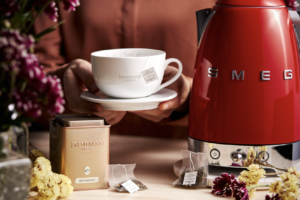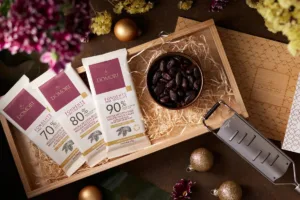What is the best food photography lens, you need to have when starting your journey? What factors do you need to consider and what is the crop factor you hear so much about? How to understand what lens to buy?
Photography can become a very expensive hobby when you are a beginner. Many new things will come to light when starting this journey. The more you dive into photography, not only it will become more expensive, but it will become more overwhelming as well.
There are so many technicalities to think about: such as cameras, lenses, equipment, artificial lighting and more. Click here to read about all the equipment I use as a professional food photographer. When I started photography, it was very overwhelming for me and that is why my mission is to make your life easier.
In this article, I want to help you understand what are the best lenses for food photography within your first two years.
The things I didn’t know at the beginning were: how my camera can influence the lens I use and I didn’t even realise there were full-frame cameras. If you are a beginner in photography, let me first explain the difference between crop sensor and full frame cameras. And how this influences the lenses you use.

This image is made with 100 mm macro Canon lens
Summary of the blogpost
How crop factor influences the choice of lens in food photography
As I mentioned above, full frame cameras and crop sensor act differently. If you don’t know exactly what kind of camera you have, just search your camera model in google. But if you don't spend a few thousands to buy your camera you probably will have a crop sensor camera.
The difference between full frame and a crop sensor camera is in the sensor: it’s called a crop factor. “Crop factor” is the ratio of the sensor size to 35mm / full-frame. The crop factor is slightly different for every camera brand.
Let’s take a look at the Canon brand: the crop factor of the 750D / a RebeliT6i is 1,61. In other words: the scene you see through a crop sensor camera is 1,61 x smaller than you see in a full frame camera.
The crop factor influences the choice of lens a lot in food photography. As I mentioned above, you will see a smaller scene via a crop sensor camera so remember that the crop factor is something you always have to take in consideration when choosing your lens.

Shot with 100mm macro lens and a full frame camera. This lens allows me to capture more details, but slightly larger scenes too, (with the help of a C-stand for example.
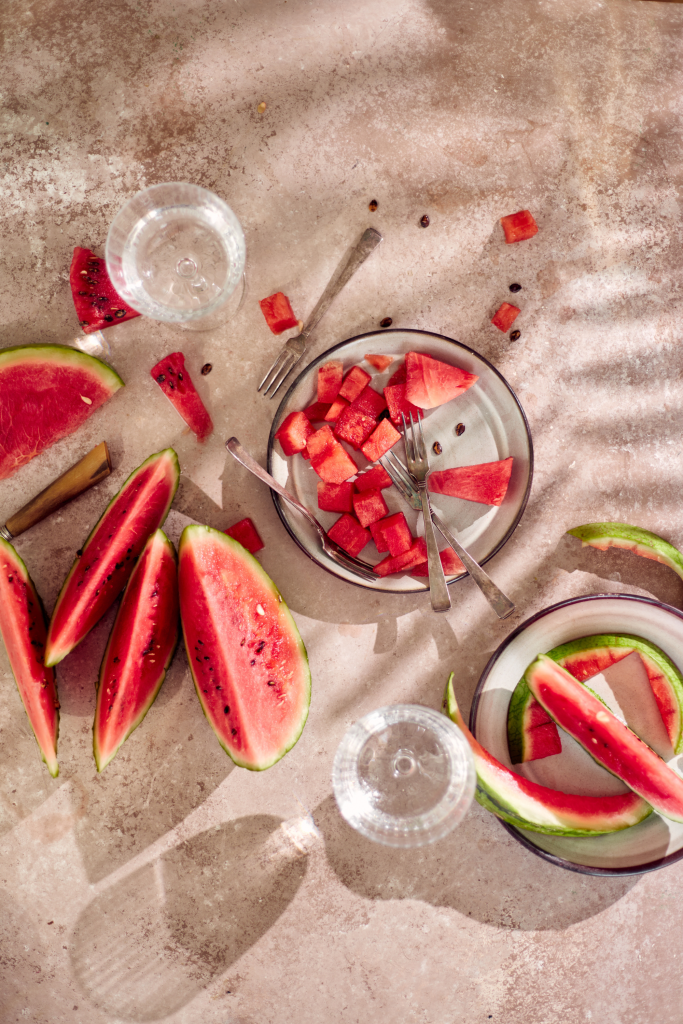
Shot with 50mm macro lens and a full frame camera. This combination allows me to capture a wider scene.
For example: A 100mm lens on a full frame camera will be 100mm. But because of the crop sensor (the crop factor) in cameras will make your scene look smaller: the size of the scene will be similar as you would use a 160mm focal length. Why? Because when you multiply 100mm x by the crop factor (1,61) = 160mm.
Let’s take another example: When starting in food photography a 50mm lens is a great one to start with. This is a wide angle lens when used on a full frame camera. But when using this 50mm lens on a crop sensor camera, would it be a wide angle? Not really, so let’s take a look at why.
The 50mm lens will act as a focal length of 80 mm, and that is because: 50mm x by the crop factor 1,6 = 80mm.
The question is now: is your camera full frame or crop sensor? And do you know your camera crop factor? If you have a crop sensor camera, knowing the crop factor is important before buying a new lens for your photography journey.

I used 100mm macro lens on a full frame Canon 6D mark ii. This lens allows me to capture juice details and having a macro feature, I can get really close to a subject.
35mm prime lens
35 mm is a prime lens and it’s a wide angle lens. What does this means? That with a 35mm lens you will be able to capture larger scenes and it’s a great lens to use in a tiny space, like your kitchen, or a small studio.
The thing is that this lens is not the cheapest but also not very expensive. But it’s a great piece of equipment to have as it gives you lots of opportunities to shoot larger table scenes on a crop sensor camera. And as it’s a prime lens, you will get a great quality image too.
The one thing to know about wide angle lenses is the distortion that occurs. You will notice that when you are shooting with wider angle lenses, you will start seeing more distortion in your images. Think of a glass of wine is enlarged or get’s a weird shape. Even though we photographers cannot completely eliminate such distortion, we can partially correct it in post production.
This lens is best for capturing flatlays (90° camera angle shots), or with a straight-on angle. These two angles are the ones, where you notice less distortion.
Because of it’s low f-stop number (f 1.4), this prime lens will be very practical to use when you don’t have enough light available.
Used on a crop sensor camera
If you have a crop sensor camera, this lens will behave as approx. 50mm focal length on a full frame camera. Why? Because of the crop factor: 35mm x 1,61 = 56,35 mm.
This lens is perfect for shooting larger flat lays, where you include lots of elements or when capturing larger scenes with a straight-on angle. I don’t recommend using this lens for other angles, as your food will not look natural. When shooting from 30-80° angle, you will notice a lot of distortion.
That is why I recommend using instead 50mm lens on a crop sensor for a better quality images when using camera angles (30-80°).
And what about changing for full frame cameras?
When upgrading your camera to a full frame sensor, this 35 mm lens will help you shoot even wider scenes. It’s great if you photograph in a small studio and you need to capture larger scene. Or when you shooting in restaurants that have tiny spaces. Capturing dishes in such situations will be easier.
Should you buy the 35 mm lens or not?
This choice depends mainly on how much you enjoy and plan on shooting larger scenes, such as my past student Edita from @edita_kt. This lens will give you a great possibility to capture more objects in frame in food photography.
The quality of the image will be great (due to the prime lens), it has an aperture of 1.4 and you will be able to use this lens in restaurants too when you start working with them in the future.

Using 100mm macro lens and a full frame camera. Credit photo: @domestika
50 mm prime lens
This lens is just perfect for everybody to start their journey in food photography.
When I upgraded for this lens, I was shocked by the quality of image this lens actually captured. It dramatically improved my images. The low f-stop number allows me to achieve the bokeh effect I wasn’t able to create with my previous 18-55mm. And I managed to shoot at low light situations too, without increasing the ISO too much.
It was my go-to lens at the beginning when food photography still was my hobby, but this lens still is a go-to lens when I do it professional pictures. Whenever I need to capture a larger scene and where my 100mm lens just doesn’t fit, I use my 50mm lens. (This is because now, I have a full frame camera).
This lens is very light and small, it’s perfect for travelling with it anywhere. And as it is a prime lens it will create beautiful sharp images with amazing colours.

I used 50mm lens on a crop sensor camera. Because of the crop factor 1.6, the actual focal lenght was about 80mm.
Used on a crop sensor camera
When used on a crop sensor camera, you will get a focal length of about 80mm. Because of the crop factor: 50mm x 1,61 = 80,50mm. This is great for capturing subject from various camera angles. You can use it for flat lays: close up shots or larger scenes, you just need a C-stand to get far enough. And camera angles between 45-70°, the food will look good.
But as this lens is not a macro lens and you can’t get too close with the camera. You will need to respect the distance so that the lens can focus on the subject. If the distance is not enough, you can crop the image in post-production. Like I did in this photo:

I captured this image with 50mm prime lens on a crop sensor camera (this made my lens work as 80mm focal lenght).
Grab my freebies and improve your skills Join my VIP e-Library and get access to all my freebies and live training replays to help grow your food photography skills.
And what about changing for full frame cameras?
This lens will be in your lens kit for years even when doing food photography as a hobby. When upgrading your camera, a 50mm lens will help capture larger scenes. It will be really easy to do the large table scenes you are dreaming of. However you will start noticing more distortion, which you can partially eliminate in post-production. Or you can slightly correct it on the scene too. This is something I teach about in my Members’ Club.
Should you buy it or not?
Oh yes, the 50mm lens was a game changer for me when starting out in food photography. And I really recommend it to everyone.
It’s a cheap lens, but don’t get confused, as it will give you a great quality image! There is also its more expensive brother: the 50mm prime lens with a f-stop number of 1.4. The quality of images is almost the same - but, there is a slight improvement with the lens of 1.4. However, the price is double for this lens which I don’t think its really necessary to get, especially when starting out.
The cheaper brother, the 50mm 1.8 really is worth the investment and will provide you with a great quality images in food photography.

Using 50mm lens and a crop sensor camera, which makes it about 80mm focal length. I shot this from about 45° angle.

Using 100mm macro lens and a full frame camera. This was shot from about 30° camera angle.
100 mm macro prime lens
The 100 mm macro lens is my go to lens when I upgraded for a full frame camera.
It’s a prime lens, so it gives you a great quality image. If you buy a macro lens, you will be able to get very close to the food, capture amazing details in food photography and get some great macro shots.
Because of the low f-stop number, it will be a great lens to use at low light conditions. This lens is just great when it comes to the distortion: due to its high focal length, the distortion will be less present.
It’s a go-to lens for all camera angles. Your food will look great, detailed and very realistic (when it comes to the distortion).
I do use this lens for flat lays too. Why? Because it causes less distortion and creates beautiful high quality images. Especially when it comes to colours & sharpness. The macro lens is a beautiful addition for food photography, when capturing some juice details of my subject
With flat lays: the most important aspect is just to get high enough, which is very easy to accomplish with a C-stand. You can have a look at my equipment further in this article.

Using 100mm macro lens with a full frame camera, standing very far from the subject, so I can capture a larger scene with this lens.

Using 100mm macro lens with a full frame camera, being very close to my subject. This allows me to capture small details.
Used on a crop sensor camera
The 100 mm macro lens on a full frame acts as 100mm but think that: on a crop sensor camera the focal length will become about 160mm. Remember the crop factor? 100mm x 1,61 = 161mm.
Although we might think it’s a very high focal length. But it actually is a great focal length for a simple reason: there is less distortion present in your images. (Remember: the higher the focal length, the less distortion you will get.)
And what about changing for full frame cameras?
If you have a crop sensor camera, when buying this lens you will definitely use it after upgrading for a full frame camera. The macro 100mm lens is a great investment and you will use it for years.
You will use this lens for all camera angles & various types of shots: slightly larger scenes to close-up shots.
Should you buy it or not?
I love this lens for food photography and I use it 90% of the time. It has been the best investment I made when it comes to my equipment. Why? Due to its high focal length, the distortion is really minimal and the colours in the images are stunning as well as the sharpness.
This lens is the best to use when shooting smaller objects: such as cocktails, small products with lots of details, pattern or texture. Think of sage leaf or tiny droplets on fruit.
If you want to wait until upgrading your camera to a full frame, I totally get you! If you are looking for an equivalent of 100mm on a crop sensor, have a look at 60mm lenses because of the crop factor the 60mm lens becomes about 90mm.
Or even better investment would be a 80mm lens because with the crop sensor camera it becomes 120mm. This way, you will add different focal lengths to your lens collection.

24-70 mm zoom lens
24-70 mm is a zoom lens, this means: when using this lens, you can zoom in and out. And this lens covers all focal lengths: from 24 to 70mm. On the contrary of a prime lens, a zoom lacks the sharpness and quality of colour in the images.
I am more a fan of a prime lenses, due to the better colours & sharpness of images. However, this 24-70mm lens is a great choice to shoot at restaurants.
For example, when having some models for the human element, you need to be quick and shoot variety of images in a short time. Or when you shoot in a tiny space like your kitchen or in a smaller restaurant, zoom lens will allow you to change focal lengths only by zooming in & out. You don't need to physically move closer & further from your subject.
After the shoot, the images captured on zoom lens will lack colour and sharpness, but this can be added and edited in post-production.
The 24-70 mm zoom lens is also my go to lens when I photograph cars (this is my hobby). I prefer this lens also because, cars are moving fast so I need to change my focal length quickly, or when shooting in a car repair workshop, zooming in or out is perfect for capturing various scenes.
This lens is not cheap but you can also get a second hand one for a good price.
Have a look at various shops where they sell photography equipment, but make sure that the lenses are checked for defaults before buying it. Even better, try it out yourself in the shop if possible!
Once you buy such a zoom lens, it will cover 24-70mm, so you don’t really need the 35mm or a 50mm prime lenses anymore. Your zoom lens will cover these focal lengths too. You can use this lens for capturing larger table scenes or close up images.
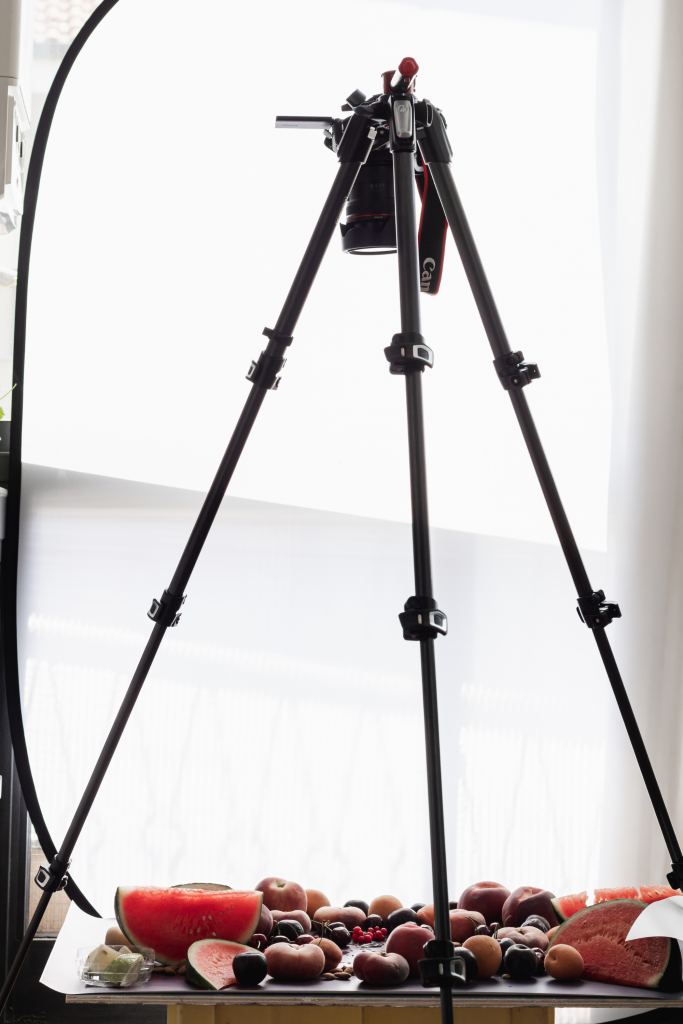
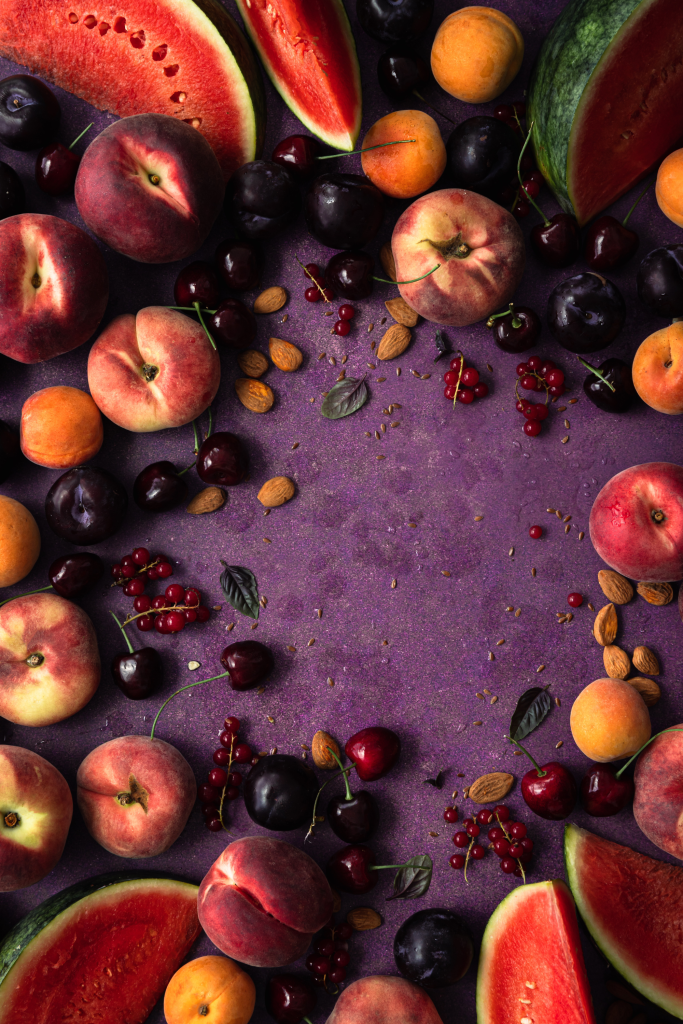
Using 24-70mm zoom lens with a full frame camera.
Used on a crop sensor camera
Using this lens on a crop sensor will provide you with a focal length from approx. 36mm to 100mm, which is a fantastic range for food photography. You will have the most important focal lengths included in this range. Buying this lens for food photography is a great investment and this way you will use 1 lens only. You will be able to shoot larger scenes and as well some close up shots.
And what about changing for full frame cameras?
This lens is a great lens for full frame cameras too. It will become your go-to lens when you photographing at restaurants, or tiny spaces. And you might do some other types of photography: like portraits or landscape. It’s because of the zoom ability: you stay in one place and all you need to do is to zoom in or to zoom out, without physically moving closer and further to the subject. Amazing right?
Should you buy it or not?
Prime or zoom lens: it’s a personal choice. I prefer prime lenses, however, this 24-70 zoom lens is really comfortable. It allows you to capture images at so many different focal lenghts. It is a great investment for a crop sensor or full frame cameras.
If you think of buying this, I do recommend this lens. If you had prime lenses before, I would advice borrowing this 24-70mm lens before buying it, so you can test it and see the images it makes. It’s a not cheap lens so make sure you are in love with the results the lens gives you.

Using 24-70mm zoom lens with a full frame camera
Things to consider when buying a new lens for food photography
Camera lenses are expensive. They costs a lot but they are the best investment you can do in photography. You might keep changing or upgrading your camera body but once you buy a good quality lens it will stay with you during your whole food photography career. You can use it on a crop sensor camera and on a full frame too.
And for this reason my advice to you is: Invest in a good quality lens instead of saving some money by buying cheaper lenses.
Consider borrowing a lens you want to buy before buying it. This way you can test it and see if you like the images, the colors, quality and sharpness. Prime lenses and zoom lenses will provide you with a different quality images.
Another thing to consider when buying a new lens is your photography style. What subjects do you like shooting the most? Do you like shooting smaller or larger table scenes? Do you like details and close ups? Do you have a small studio, your kitchen counter or bigger space?
Answering those questions will guide you when choosing the right lens for you.
However don’t let this block you from buying the lens you want. Your style might change in the future and getting a lens that helps you get out of your comfort zone is a great way to experiment and work on growing your skills.
Prime vs zoom lens really is a personal preference. Remember that prime lenses will give you better quality images as they are able to capture colours better and the images will be sharper too.
On the other side zoom lenses gives you the flexibility to zoom in and out. This will come in handy in various situations: when shooting in restaurants or in tiny spaces.
Once you buy a zoom lens, such as 24-70mm: it will cover the whole range of focal lengths you might need when shooting on a crop sensor camera. Remember the crop factor … x 1.61? So instead of focal lengths of 24-70, you will get the focal lengths of 35-110mm.

This is shot with 100mm prime lens & full frame camera. I always prefer this lens when doing a client work, due to the quality of images the prime lens gives me.
Having doubts in which lens you should buy for your food photography journey?
Having doubts about buying the right lens for food photography? That is very normal, so my advice to you: talk to your mentor because it’s important to discuss this with someone who knows the equipment. This way, you don’t end up buying something you don’t really need. Or that you buy lenses that are so close to one another in terms of focal lengths.
If you have 50mm lens you don’t necessarily need to buy a 60mm lens. it’s a better purchase an 80mm lens. Why? Because these focal lengths are further from one another and you will create a larger variety of lenses in your collection.
If you don’t have any mentor and you are looking for one I will be happy to help you with anything you need! I would give you advice and redirect you to chat about it in our private forum in the club, but also we have many live calls every month where I discuss many topics with my members in our Members’ Club.
It’s all about what you want to see in the images, the quality, the space you have in your studio or even in your kitchen! And if you still feel lost in your choice of finding the right lens for food photography after reading this article, please reach out to me in the comments below, or via Instagram and I will guide you through this process!

Using 50mm prime lens with a full frame camera

Using 100mm prime lens with a full frame camera
Thank you for reading!
Thank you for stopping by!
If you want to dive into food photography, and take your skills to the next level, I invite you to join our Members’ Club. We have food photography courses, masterclasses, an amazing community of other like minded creatives. This is the environment that will inspire you, motivate you and help you progress more and faster towards your goal.
Let me know about your gear in the comment s or on Instagram! You will find me as @foodlight.io. I am excited to hear from you!

Hi there! I'm Lucia
Award Winning Food Photographer, Teacher, Business Coach, and, Founder of FOODlight.
I am passionate about food photography, online business, sharing my knowledge & building a community of amazing like-minded creatives, such as yourself, that inspire and support each other.
Feel free to reach out to me via my email lucia@foodlight.io or via Instagram, I'll be happy to connect with you!




